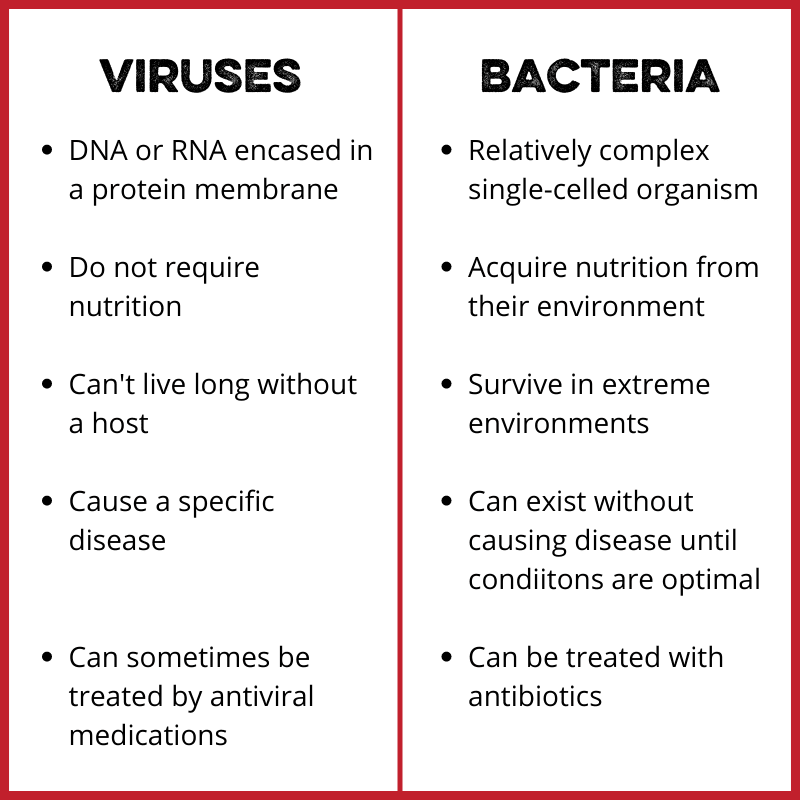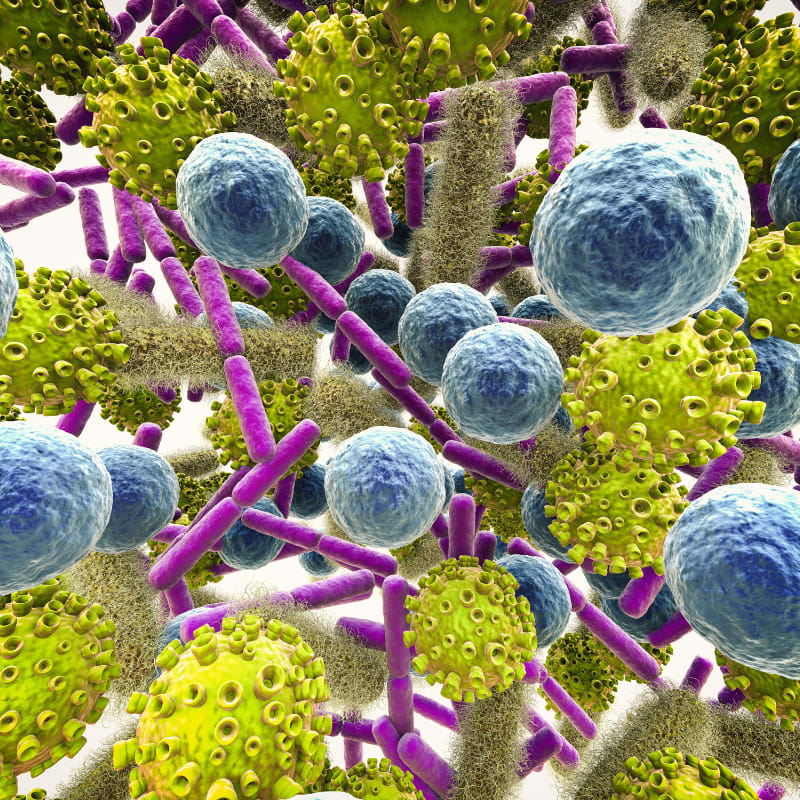Tiny Threats Can have a Huge Impact
Healthy birds are happy birds and happy birds are more productive birds. As poultry farmers, we know your number one priority is growing a healthy and productive bird.
In the world of poultry production, there are a ridiculous number of things that can make your birds feel under the weather. But believe it or not, some of the smallest offenders can make the largest impact. We're talking microscopic!
Viruses and bacteria, though microscopic, can negatively impact feed conversion, growth rate, breeding and egg production on your farm. In recent years, it has been estimated that the total economic loss from disease is about 20% of the value of poultry production, which is about 3 times the economic loss from mortality. That means that the poultry industry is losing about 20% of its potential profit from challenges caused by disease separate from bird mortality.
Living organisms that cause disease are often referred to as “infectious agents”. These include parasites, external pests and fungus. Some of the most concerning of these in poultry environments, however, are viruses and bacteria. These little “bugs” have an uncanny ability to find their way into houses and wreak havoc.
Though both very small, viruses and bacteria have some very important differences that can help you understand how and why they might be affecting your flock.
3 Main Differences in Viruses and Bacteria
Bacteria and viruses differ in 3 major ways—cellular complexity, their ability to survive, and disease specificity.
1: Cellular Complexity
Complexity refers to the biological make-up of viruses and bacteria. Bacteria are single celled living organisms that reproduce through binary fission. Viruses, on the other hand, are not even truly living organisms.
Living organisms are defined as being able to grow, reproduce, maintain internal conditions, and react to stimuli. Viruses are very simply a collection of genetic material—DNA or RNA—enclosed in a membrane. In order to reproduce, they have to invade a host cell and hijack machinery found there. Because of this, viruses do not meet the requirements to be considered "living," while bacteria do.
2: Ability to Survive
Along with complexity comes the ability to survive. Since viruses are not living, they cannot persist in the environment for very long. Anything with the ability to damage their membranes will “kill” them. This can include UV light, intense heat or cold, natural surfactants, and disinfectants. Certain viruses are hardier than others and possess additional membranes but as a general rule, they will not be around very long!
Bacteria, however, are a different beast. Bacteria can live in a well-suited environment for up to 5 years—sometimes longer. This is made possible in part by their ability to acquire nutrients from their surroundings. They can also make specialized adaptations better suit their home, whether that means extreme heat tolerance or the ability to photosynthesize.
3: Disease Specificity

While bacteria can be fairly specific about where they want to live, they aren’t always so concerned about where they invade. Most bacterial infections are due to the proliferation of an opportunistic organism. Take clostridium for example! Clostridium is ever present in a poultry environment and can even exist without causing problems. But given a bird with poor gut health or a floor that’s a little too moist, these bacteria can easily lead to necrotic enteritis or foot pad dermatitis.
Viruses on the other hand are extremely specific to what systems and even what cells they target. In the case of Avian Influenza, viral cells target a receptor found in the respiratory tract of avian species. Other species, including humans, have these receptors much deeper in their respiratory tracts, making it more difficult for them to become infected.
Treating Viruses and Bacteria for Poultry
Luckily for us, various vaccines are available for both of these infectious agents and allow us to protect our birds from disease. In both virus and bacteria vaccines, portions of genetic material of the organism or toxins it produces are used to pre-expose the bird. This ensures that the next time it meets the same challenge, its immune system is prepared! These vaccines along with supplements like probiotics and vitamins can help ensure that your birds remain healthy no matter what they face.
Wild Birds can be Infected Birds
One of the main routes of exposure to both bacteria, viruses and even parasitic diseases is other birds. Wild birds and even birds from other farms can be sick birds or carriers of germs. This is where biosecurity comes into play!
Poultry House Biosecurity
Before long, we'll be posting a video specifically about the basics of poultry biosecurity. But for now, here are a few tips to help promote biosecurity and prevent infectious agents from entering your houses.
If you are visiting another farm, be sure to take precautions such as showering,

changing clothes, and disinfecting your vehicle before entering their farm or returning to your own.
It is always a good idea to limit contact with waterfowl, backyard flocks, and fairs or poultry shows. In cases where contact cannot be avoided, be sure to take proper precautions.
Be sure to thoroughly clean anything you borrow before introducing it to your farm. Items made of wood or cardboard should not be shared due to the material's porous nature which makes it very difficult and almost impossible to clean adequately.
Be sure that everyone entering the farm and especially the houses are aware of the importance of biosecurity and proper use of available PPE and disinfectants.
Common Poultry Diseases
Examples of Viruses in Poultry
-
Highly Pathogenic Avian Influenza
-
Newcastle Disease
-
Fowl Pox
-
Inclusion Body Hepatitis
-
Infectious Laryngotracheitis
-
Marek’s Disease
-
Egg Drop Syndrome
-
Infectious Bronchitis Virus
Many of these diseases can infect chickens as well as other birds like turkeys, quail, ducks and guinea fowl.
Examples of Bacterial Diseases In Poultry
-
Chronic Respiratory Disease
-
Fowl Cholera
-
Infectious Coryza
-
Colibacillosis
-
Bordetellosis
-
Necrotic Enteritis
-
Pullorum
Affected birds can experience issues in their gastrointestinal tract and upper respiratory tract, and young birds are especially susceptible to mortality from these bacterial diseases.
Let's Review

So, let’s review. There are three main differences between bacteria and viruses.
One: bacteria are alive, but viruses are technically not.
Two: Bacteria tend to have special adaptations that allow them to survive in their chosen environment. Most viruses aren’t so hardy.
Three: Bacteria can exist in your coop without you knowing it until they find an opportunity to thrive, and an issue occurs. Viruses, on the other hand, attack very specific part of the bird following introduction.
In a perfect world, everyone would start their day with a nice cup of coffee and houses full of healthy birds. Unfortunately that may not always be the reality. From bacterial infections such as necrotic enteritis and fowl cholera to viral diseases like infectious laryngotracheitis and fowl pox, it would seem that some little bug is always waiting for the right moment to take over.
But with poultry vaccines and immune system support through probiotics and vitamins, you can prepare your birds to fight these microscopic menaces. As I said, healthy birds are happy birds, and happy birds are more productive!
I hope you found this video helpful and if you have, please like and subscribe to our YouTube channel so you won’t miss a thing! If you have any questions, you can reach out to alyssa@southlandorganics.com or call 800-608-3755.






